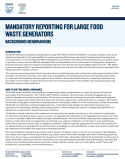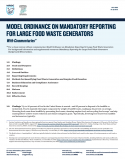
Research Reports
ELI publishes Research Reports available for free download that present the analysis and conclusions of the policy studies ELI undertakes to improve environmental law and policy. These reports contribute to education of the profession and disseminate diverse points of view and opinions to stimulate a robust and creative exchange of ideas. Those publications, which express opinions of the authors and not necessarily those of the Institute, its Board of Directors, or funding organizations, exemplify ELI’s commitment to dialogue with all sectors.In 2021 and 2022, the Environmental Law Institute (ELI) hosted three workshops that, at least in part, addressed how states, territories, and tribes have considered and could consider climate change in the listing/reporting of waters that do not meet water quality standards, the development and implementation of water quality restoration and protection plans, and related activities and products. This document is a brief summary of the practices and ideas conveyed in those forums.
Read More >In 2021 and 2022, the Environmental Law Institute (ELI) hosted three workshops that, at least in part, addressed how states, territories, and tribes have considered and could consider environmental justice in the listing/reporting of waters that do not meet water quality standards, the development and implementation of water quality restoration and protection plans, and related activities and products. This document is a brief summary of the practices and ideas conveyed in those forums.
Read More >
Enforceable policies (EPs) are the backbone of federal consistency review. They provide the substantive standards on which state and territorial coastal management programs (CMPs) rely to influence federal actions in and affecting the coastal zone through the federal consistency process, pursuant to Section 307 of the Coastal Zone Management Act (CZMA) (16 U.S.C. § 1456).
Read More >
Up to 40 percent of food in the United States is wasted—and 95 percent is disposed of in landfills or incinerated. Diverting food waste from landfills by preventing food waste, donating surplus food, and recycling food scraps can help municipalities achieve waste reduction and climate mitigation goals. However, many municipalities do not have data on the food wasted in their jurisdictions. Requiring organizations and companies that produce large amounts of food waste to report their waste is an important first step in reducing that waste.
Read More >
Up to 40 percent of food in the United States is wasted—and 95 percent is disposed of in landfills or incinerated. Diverting food waste from landfills by preventing food waste, donating surplus food, and recycling food scraps can help municipalities achieve waste reduction and climate mitigation goals. However, many municipalities do not have data on the food wasted in their jurisdictions. Requiring organizations and companies that produce large amounts of food waste to report their waste is an important first step in reducing that waste.
Read More >